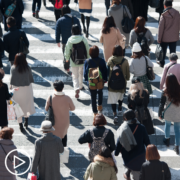What Are the Latest Acute Myeloid Leukemia Therapies?
What Are the Latest Acute Myeloid Leukemia Therapies? from Patient Empowerment Network on Vimeo.
What are the latest treatments in acute myeloid leukemia (AML)? Dr. Catherine Lai from Penn Medicine discusses the increase in available AML treatments. Learn about combination therapies and treatment options for patients with IDH1, IDH2, and FLT3 mutations.
[ACT]IVATION TIP from Dr. Lai: “Ask your physician and your oncologist when you’re talking with them about what all the newest therapies are and what would be specifically the best treatment for their specific leukemia with respect to the different mutations.”
Download Resource Guide en español
Related Resources:

How Can We Address Disparities in AML Among Diverse Populations? |

|

What Promising AML Treatments Are Available for Newly Diagnosed Patients? |
Transcript:
Art:
Dr. Lai, for newly diagnosed AML patients, what are the latest available therapies?
Dr. Catherine Lai:
That’s a great question. The last, I would say, a handful of years have really seen a dramatic increase in the number of new treatment options for AML patients, specifically since 2017, the FDA has approved 10 new drugs for AML, that’s both for patients who are newly diagnosed and in the relapsed refractory setting.
And so what I would say is that we break our patients into two different categories in terms of being able to tolerate intensive chemotherapy versus non-intensive chemotherapy, and as well as looking at specifically targeted mutations that patients may have so that we can better understand the disease but also treat these patients more specifically to try to maximize efficacy while minimizing toxicity.
And so specifically, I would say for patients who have FLT3 mutations, there are drugs such as midostaurin (Rydapt) and gilteritinib (Xospata), there are drugs for mutations in IDH1 and IDH2, enasidenib (Idhifa) and ivosidenib (Tibsovo) and recently, or in December of 2022, olutasidenib (Rezlidhia) was also approved for IDH1-mutated patients as well.
We have a general targeted agent that’s an oral chemotherapy that probably has made the biggest difference in how we treat patients called venetoclax (Venclexta), and that’s used in combination with azacitidine (Onureg) or decitabine (Dacogen), or low dose cytarabine (Cytosar).
Although most commonly in the United States, we use azacitidine or decitabine in combination with the venetoclax, and that I think is really what I’d say has been practice changing for the most part, in terms of both increasing the complete remission rates as well as the overall survival for these patients. So I would say there are a lot of new drugs. It is all very exciting.
The biggest activation tip in terms of takeaways is to ask your physician and your oncologist when you’re talking with them about what all the newest therapies are and what would be specifically the best treatment for their specific leukemia with respect to the different mutations.
Art:
Okay. Dr. Lai, what are the latest approaches to combination chemotherapy to treat AML?
Dr. Catherine Lai:
So, the latest approaches for combination chemotherapy would be in the combination of a hypomethylating agent, azacitidine or decitabine in combination with venetoclax. This is the most practice-changing combination that has been approved since 2017 to 2018, and now more recently, what’s been happening is now looking, so we call that a doublet, and now it’s been looking at…what we’ve been studying is now whether or not triplets are more effective, when we do have triple combinations, we do see an increase in toxicity and so on, we haven’t come up with the right algorithm in terms of what that exact formula should be, but often I think about it in kind of a three-fold in terms of wins the right time, what’s the right combination, and how do we see in the drugs, and I think the sequencing is the biggest thing that we don’t yet know, and how do we combine the two different..two different drugs in a way, and how do we give them in a way that will maximize efficacy, will minimize the toxicity, so as an example is, Do we give two drugs for a specific period of time, and then after some determined time point, do we…
And change it to a different set of combination of drugs to make sure that patients are getting the most benefit of the drugs, and we don’t know that yet, but I think that that’s where the general direction…where the landscape is heading, so the activation tip I would take home from this is just to have a conversation with your physician about potential clinical trials and how combination therapies are being used.



